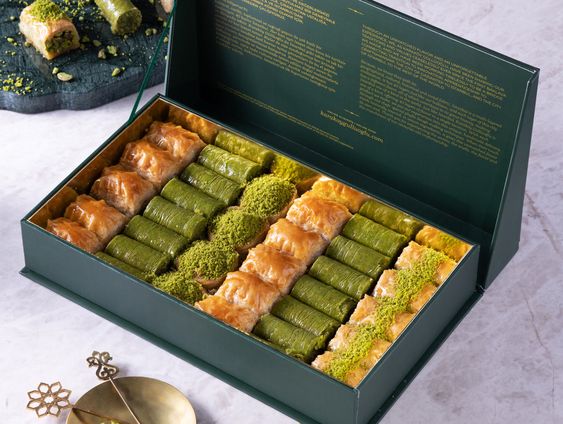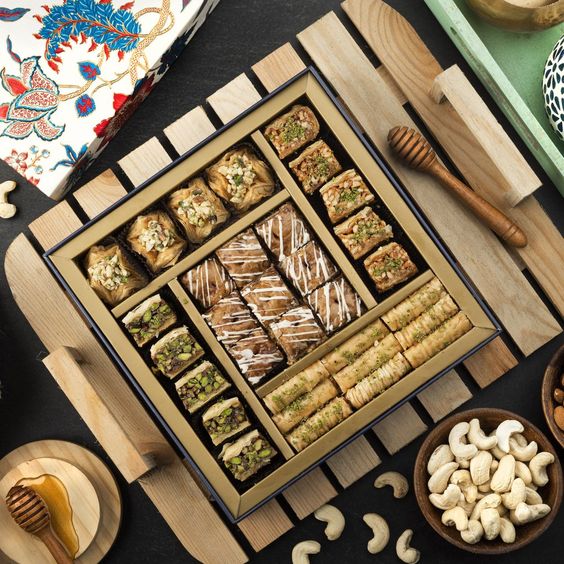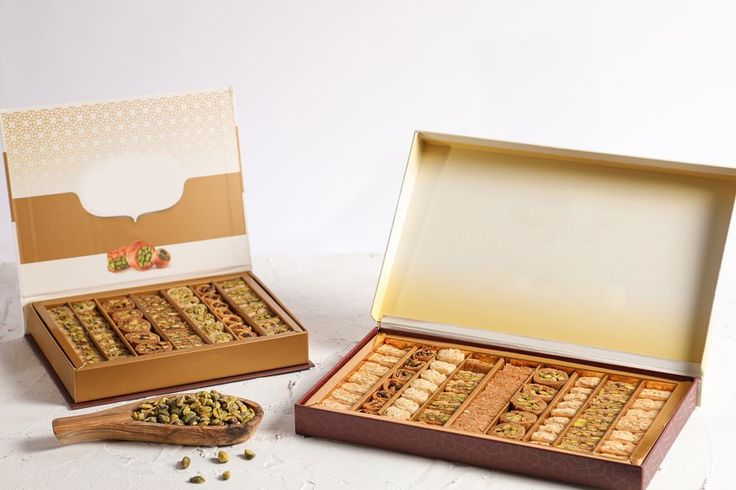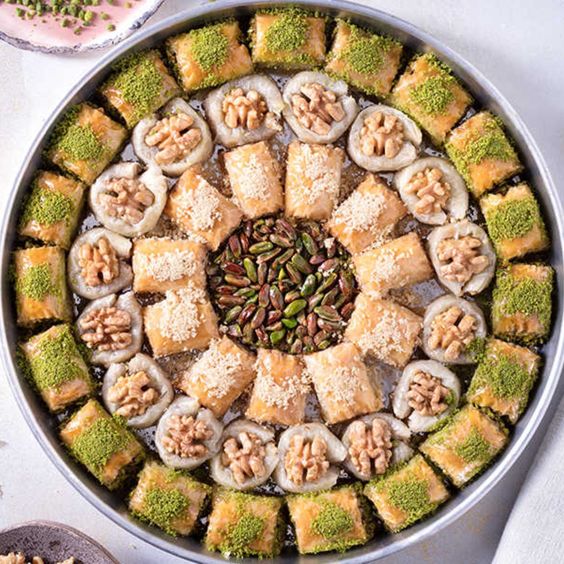Shrink and stretch packaging processes of of assorted box of baklava
A sandstorm refers to a weather phenomenon in which strong winds raise dust and sand on the ground, making the air turbid, and the horizontal visibility is less than 1km. In addition to expressing the concentration and sedimentation amount, its intensity can also be expressed by the number of sandstorm days. Sandstorms are more serious in northern my country. Sandstorms are mainly concentrated in spring every year, with April being the most severe, accounting for about all sandstorms.
50% of the number. The harm caused by dust and sand to packaging assorted box of baklava and products is mainly caused by penetration and wear. Dust suspended in the air is mostly small in diameter but has a certain hardness. Along with strong wind, dust, and sand, it is easy to penetrate into the package that is not tightly sealed. After a long period of time, it will cause wear and other damage to the package. In addition, some acidic or alkaline ash
Dust easily absorbs water vapor and deliquesces, accelerating the corrosion of packaging. With the rapid development of modern industrial technology and the expansion of international trade, the circulation area of packaging products is becoming wider and wider, and the meteorological and environmental conditions experienced by packaging products during the circulation process are becoming more and more complex and diverse. Products are affected and restricted by various environmental conditions during production, storage, transportation, and use. It is especially important to ensure the quality and safety of packaged products under high temperature, low temperature, high humidity, low humidity, low pressure and other meteorological conditions. To this end, only by conducting a reasonable analysis of meteorological environmental conditions can we formulate reasonable safety standards and systems, correctly select environmental protection measures for products, and ensure that products can withstand the impact of harsh climate environments and are safe and reliable during use.

The basic mechanism of protective packaging assorted box of baklava is to design reasonable protective packaging based on the basic characteristics of the packaged object and the circulation conditions of the package, to block or delay changes in the quality indicators of the packaged products, so that the product can meet the requirements of product protective packaging during the shelf life. The reasons for changes in the quality of packaging products are nothing more than the variability of the quality indicators of the product itself and the impact of circulation environmental conditions on its quality indicators. Packaged products are in a circulation environment, and there is exchange and transmission between the circulation environment and packaging that affects product quality indicators, and this mutual exchange and transmission will directly lead to a decline in product quality indicators.
Shrink packaging assorted box of baklava or shrink film wrapping is a method that uses a plastic film with heat shrinkability to wrap the packaged items, and then heats it. The packaging film shrinks by itself according to a certain proportion and fits the packaged items tightly. Stretch packaging or stretch film wrapping is a method of wrapping the packaged items by using a stretchable plastic film to stretch the film at room temperature.
The principles of these two packaging methods are not the same, but the packaging effect is basically the same. They both have the property of wrapping the packaged items tightly. The principle, materials used and effects of this wrapping method are quite different from the wrapping method mentioned above, and the material undergoes great deformation.
The cartoning method is closely related to the supply of boxes and box blanks, product objects, whether to combine packaging and cartoning equipment, etc., and the time required must be considered comprehensively. Generally, the selection is determined according to the following four principles.
(1) Selection of cartons The selection of cartons is the basis for determining the cartoning process. Mainly considering the characteristics and packaging requirements of each product, actual production should be comprehensively considered based on the current production technology status, equipment investment, management technology level, etc.
(2) The supply of boxes and roll materials must consider the source of the boxes and roll materials. Prefabricated boxes and boxes are generally entrusted to professional box-making factories for processing. The quality of the cartons is guaranteed and the varieties are diverse, which can save a lot of equipment investment. At the same time, the cost of cartons needs to be considered. Currently, the cost of some special prefabricated boxes is relatively high. The cost of packaging assorted box of baklava materials is lower when using roll materials for box making and packaging, but usually the investment in equipment is large and the variety and quality of cartons are limited.
(3) Cartoning process The choice of cartoning process should be determined based on the characteristics of the product, carton type and characteristics, output, packaging machinery performance and equipment investment.
(4) The degree of automation and production capacity of cartoning equipment. The degree of automation and production capacity of packaging machinery are selected according to the batch size, production capacity and frequency of product changes. In the integrated production line of product production and packaging, packaging machinery It must be adapted to the productivity of product production equipment to ensure the continuous and efficient operation of the entire production line.
Linju's combination is like Chushan Lake's two-hearted connection, Jia and Erju's reunion
1.Yibo wedding utensils

Tape is a strip of material pre-coated with an adhesive. It is mainly used to seal packaging containers and is also used to connect two objects. Commonly used tapes include ordinary tape and pressure-sensitive tape (single-sided, double-sided, foam, etc.). 1. Ordinary tape
Ordinary tape is also called rewet tape, or tape for short. It coats a layer of water-activated adhesive on different base materials. When used, a layer of water is applied to the adhesive surface to dissolve the adhesive and generate adhesive force, so that the adherend can be pasted. The base materials include paper cloth, fiber reinforced paper, composite materials, etc. It is mainly used to seal the joints between the center and the ends of corrugated boxes. The adhesive force of the tape can generally be divided into initial adhesive force and long-lasting adhesive force. Currently, there is no tape with both strong adhesive force. The stronger the initial adhesive force is, the more durable it is. The weaker the adhesive force. Pasting operating conditions and usage conditions have a great impact on the adhesion, mainly including ambient temperature, ambient humidity, coating water temperature and coating water amount. Ordinary tape needs to be dissolved in water when used.
It is inconvenient to use and is rarely used in daily production and life. The Ningyu case caused a stir in the sea, and there was a moving order code.
2. Pressure sensitive tape

(1) Types and characteristics of pressure-sensitive tapes Pressure-sensitive tapes apply pressure-sensitive adhesive on the base material. When using, you only need to gently press the back of the base material to bond to the surface of the adherend. No solvent or solvent is required. Heated, and the back side of the substrate can be anti-adhesive, making it easy to pull off the tape roll for use. Common ones include single-sided, double-sided and foam glue coating.
The range and types of labels used in the packaging field are expanding day by day. The materials used include cardboard, composite materials, metal
Foil, paper, plastics, fiber products and synthetic materials. Commonly used labels can be divided into three major categories. The first category is adhesive-free and the base material is uncoated paper and coated paper; the second category is self-adhesive, including pressure-sensitive adhesive and heat-sensitive adhesive; the third category is Runyuan type can be divided into ordinary glue type and particulate glue type. Their characteristics and pasting methods are:
Non-adhesive labels: Ordinary paper labels without adhesives are affixed with hydrosol and are still widely used. Most of the paper is single-sided coated paper, and a considerable amount of uncoated paper is also used. This type of label is used for large-volume items such as beer
Beverages, wine and canned food, etc.
(2) Pressure-sensitive self-adhesive labels (also called self-adhesive labels) are coated with pressure-sensitive adhesive on the back and then adhered to release paper coated with silicone. When using, remove the label from the release paper and stick it on the product. Pressure-sensitive labels are available individually or adhered to rolls of release paper. Pressure-sensitive labels can also be divided into two types: permanent and removable. The permanent adhesive can stick the label in a certain position for a long time. If you try to remove it, it will damage the label or damage the surface of the product. The removable adhesive can remove the label after a certain period of time without damaging the surface of the product.
(3) Thermal self-adhesive labels. There are two types of labels: immediate type and delayed type. The former will stick to the surface of the object after applying a certain amount of heat and pressure, and is suitable for pasting small flat or convex objects; the latter changes to a pressure-sensitive type after being heated, without directly heating the object, and is suitable for food and other products.
(4) Wet type label This type of label is an adhesive label that uses two kinds of adhesives, namely ordinary glue and micro-particle glue. The former applies a layer of insoluble adhesive film on the reverse side of the paper base material, while the latter applies the adhesive to the base material in the form of tiny particles. This avoids the curling problem that often occurs with ordinary adhesive paper assorted box of baklava, and its processing efficiency and reliability Higher sex.
Bundling is the use of flexible strip materials to fasten, fix, and reinforce items or packages. There are five basic types of strapping materials: steel wire straps, chemical fiber rope straps, nylon straps, polypropylene straps and polyester straps. When bundling, choose the most appropriate bundling material according to the specific situation.
(1) Strength: The strength of strapping tape is measured by breaking strength and tensile strength. Appropriate selection can be made according to the load and strength of the package.
(2) Working range The working range refers to the maximum and minimum values of the tensile force that the strapping belt can bear. Generally, the tensile force that the strapping belt can withstand within the working range is 40% to 60% of the breaking strength.
(3) Continuous tensile stress. After the strapping belt is stretched, tensile stress will be generated in the strap, and the stress must be kept unchanged for a certain period of time. The best retention is the steel strap, followed by polycool and nylon straps.
(4) Elongation and recovery rate Elongation (elongation) refers to the degree of elongation of the strapping after being subjected to tensile force, measured as a percentage; recovery rate refers to the amount of extension of the strapping after the tensile force is removed. For the three types of plastic strapping tapes, nylon tape has the highest recovery rate, followed by polypropylene tape and polyester tape.
3.Bundling process ofassorted box of baklava

(1) Tying equipment Commonly used strapping equipment includes the following categories:
(2) Manual strapping equipment. There are 3 types: manual, pneumatic and electric, which are convenient and flexible, low in efficiency and suitable for mobile use.
2 semi-automatic strapping machines. The packages are placed in the appropriate position, bundled together after the machine is turned on, and moved to another position manually. Wrapping, tightening, splicing and cutting are all completed automatically.
3 Fully automatic strapping machine. All operations are completed automatically according to prescribed procedures.
(3) Bundling operation: Before bundling, both manual and motorized, the strapping tape should be wrapped in the height direction of the object, and wrapped in 1 to 3 crosses or tic-tac-toe shapes, then tighten the strap and connect the two ends of the strapping tape. Iron hoops can be used as the connection method. For plastic bundling, thermal bonding is currently widely used.
Post time: Sep-12-2023

